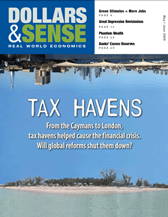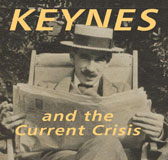The General Theory and the Current Crisis: A Primer on Keynes’ Economics
Intro | Pt. I | Pt. II | Pt. III | Pt. IV
Part II: Keynes and the Limits of Monetary Policy
This is a web-only article from the website of Dollars & Sense: The Magazine of Economic Justice available at http://www.dollarsandsense.org

This is a web-only article, available only at www.dollarsandsense.org.
Subscribe Now
at a 30% discount.

As the United States has plunged into financial crisis and the deepest recession since the Great Depression, the U.S. Federal Reserve (the “Fed”) has pursued an aggressively “expansionary” monetary policy. Monetary policy refers to government policies affecting the money supply or interest rates. Expansionary monetary policy is aimed at increasing the money supply or lowering interest rates. The idea is that, by lowering interest rates, the government can stimulate investment (such as firms’ purchases of new equipment and construction of new plant). Projects that would not be profitable for a company if it had to borrow at a higher interest rate could be profitable if borrowing were less costly. Fed policymakers hope, then, that lower interest rates will encourage investment and bring about renewed economic growth.
The main interest rate the Fed targets is the “federal funds rate,” the interest rate that banks charge each other for overnight loans. For all of 2006 and 2007, the federal funds rate stood at over 4%. In the course of 2008, as the financial crisis and recession grew deeper, the Fed moved aggressively to cut interest rates. By the end of the year, the federal funds rate was 0.0-0.25%, where it remains today. Even with the federal funds rate basically at zero, however, the economy has spiraled deeper into recession. GDP shrank at an annual rate of 6.2% in the fourth quarter of 2008 and the official unemployment rate climbed to 8.5% by March 2009.
Are Interest Rates Coming Down?
Firms and consumers cannot borrow at the federal funds rate. Then why does the Fed try to bring down the federal funds rate when it wants to stimulate economic activity? Fed policymakers hope that by pulling down very short-term interest rates that do not directly affect firms and consumers, they can indirectly pull down longer-term interest rates that are important to firms and consumers.
Interest rates on 30-Year Fixed-Rate mortgages have declined, reaching historic lows under 5% in March 2009. The low mortgage rates, however, may be deceptive. Mortgage lenders have generally tightened lending standards, and the low rates are only available to borrowers that banks consider very safe. Other borrowers may pay rates several percentage points higher, or be unable to borrow at all. Meanwhile, banks have raised credit-card interest rates and dramatically tightened borrowing limits.
Key corporate interest rates have not come down. Moody’s AAA bond rate, an index of the interest rates on long-term bonds for low-risk corporate borrowers, was about the same in March 2009 as in January 2008 (about 5.3%). Moody’s Baa bond rate, the equivalent index or higher-risk corporate borrowers, has gone from about 6.5% in January 2008 to over 8% in March 2009. The spreads between these rates and the federal funds rate have increased dramatically as the federal funds rate has fallen.
That would come as no surprise to John Maynard Keynes. Keynes argued, in The General Theory of Employment, Interest, and Money (1936), that during boom periods the general estimation of risk by both lenders and borrowers is “apt to become unusually and imprudently low.” Lenders loan out money freely, even recklessly, accepting a low rate of interest relative to the risk involved. During crisis periods, on the other hand, lenders often become much more risk-averse, parting with their money less freely, and insisting on a higher rate of interest in exchange for the risk of not being paid back. This is sometimes known as the “flight to liquidity” or “flight to safety.”
Keynes’ analysis suggests that during economic crises the interest rates on assets that are considered very safe—like government bonds—are apt to go down, since people are looking to avoid losses and willing to accept a low rate of return to do so. But the interest rates on riskier assets may go up. A rise in the interest rates that firms or consumers pay would tend to deepen—rather than correct—an economic downturn.
Can’t the Fed Do More?
If interest rates are not low enough to turn the economy around, then why doesn’t the Fed increase the money supply some more—until interest rates are low enough? The answer is that nominal interest rates can reach a lower bound below which they cannot decline further. (The “nominal” interest rate, in contrast to the “real” interest rate, does not account for changes in the purchasing power of the dollar due to inflation.) This lower bound can be greater than 0%, but cannot be lower than 0%. The federal funds rate is now about 0%. When interest rates reach this lower limit, the economy is commonly described as being caught in a “liquidity trap.”
People hold their wealth in the form of bonds rather than money because they can earn interest on bonds. For example, you may be able to buy a bond for $100 that promises a payment of $110 in one year. That gives you a 10% annual interest rate (you loaned the bond issuer $100 for a year, and at the end of the year get your $100 back plus $10 interest). That is the incentive to buy the bond instead of just holding money.
Suppose the Fed wants to lower interest rates to stimulate spending. It offers to buy government bonds (previously sold to the public) at a higher price, driving down the interest rate. For instance, the Fed might offer $110 for bonds that promise $110 in one year. If you were to buy such a bond at the new price of $110, you would receive the same amount of money back a year later. The interest rate on that bond is now 0%. The idea of the policy is that banks will sell their government bonds to the Fed at the new higher price, take the money and buy other bonds (such as those issued by corporations), driving up their price and lowering the interest rate on those bonds.
Imagine that the Fed, however, decided that an interest rate of 0% was not low enough, and decided instead to pay banks $120 for bonds that promise $110 in a year. The banks would gladly sell their bonds, so the money supply would increase. But they would not loan out the money they received at a negative interest rate (paying consumers or firms to borrow from them). They would be better off just keeping the money in their vaults. In other words, once the interest rate reaches 0%, there is nothing more that the government can do with conventional expansionary monetary policy. That is the liquidity trap—any extra liquidity (money) the Fed makes available gets trapped, instead of being loaned out.
Monetary Policy and Interest Rates Today
Economic journalists and commentators have inaccurately described “interest rates” as being at or near 0% these days. The federal funds rate has hit rock bottom, but other interest rates clearly have not. Keynes was acutely aware that, when monetary authorities limit themselves to buying short-term securities, the “effect may … be mainly confined to the very short-term rate of interest and have but little reaction on the much more important long-term rates of interest.”
In a famous passage in The General Theory, Keynes notes the possibility that “after the rate of interest has fallen to a certain level … almost everyone prefers cash to holding a debt which yields so low a rate of interest.” This passage is often taken to be Keynes’ description of the liquidity trap. He goes on to say that he did not know of any case when this had actually happened and notes that it is not likely to happen “owing to the unwillingness of most monetary authorities to deal boldly in debts of long term.” It is clear from this passage that Keynes was not describing merely a situation in which certain short-term interest rates targeted by the government (such as the federal funds rate) were pushed to their lower limits, but rather one in which all interest rates hit rock bottom — a different situation from what is commonly referred to as a “liquidity trap” today.
Keynes viewed monetary policymakers’ focus on certain short-run interest rates not as an inherent limitation in monetary policy, but as a limitation in the ways monetary policy was conventionally practiced. He notes that governments did not usually buy long-term bonds and drive down long-term interest rates, but that there was no reason they could not. In March, the Fed actually began to do just that, buying billions in long-term government securities in an attempt to bring down long-term rates. The 10-Year Treasury Bond Rate dropped dramatically (from about 3% to 2.5%) the day the purchases began. It has increased somewhat since then, but remains lower than it was before November 2008.
Any attempt to revive private investment by manipulating interest rates, however, faces at least two additional barriers:
First, the interest rates consumers and firms pay do not move in lockstep with interest rates on government securities, either short-term or long-term. The contrast between short-term and long-term bonds is not the same as the difference between relatively safe government bonds and riskier corporate bonds or consumer loans. As we have seen, interest rates on corporate bonds have failed to decline, even as rates on long-term government bonds have declined. Banks’ consumer lending standards, likewise, have tightened even as the Fed has driven down interest rates on government bonds.
Second, economic activity simply may not change dramatically in response to changes in interest rates, especially during a recession. Expectations of future sales and profits are extremely negative, so firms are dramatically slashing payrolls and investment spending. Total employment has decreased by over ½ million people for each of five consecutive months from November 2008 to March 2009. Nonresidential fixed investment decreased by over 20% in the last quarter of 2008; investment in nonresidential structures by nearly 10%. Firms have inventories they cannot sell, are laying off workers, and are producing below their existing productive capacity. Most of them are not going to make large investments in new plant and equipment under such conditions.
For these reasons, Keynesian economists have advocated a very large fiscal stimulus. Fiscal policy, in contrast to monetary policy, involves government spending and taxation. A fiscal stimulus program involves increases in government spending or reductions in taxes. Keynesian economists, believing that monetary policy is not adequate to pull the economy out of its current crisis, have argued especially for a dramatic increase in government spending as the surest way to revive overall spending, production, and employment.
Did you find this article useful? Please consider supporting our work by donating or subscribing.
